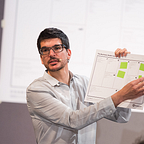Entrepreneurs, Don’t Build Too Soon
Co-authored by Benson Garner.
Entrepreneurs and intrapreneurs often start building early versions of their products and services way too soon. They don’t realize that the search phase of building a new product or business is optimized for learning.
The goal early on is to create the most learning as quickly and efficiently as possible.
In this post we explain how to correctly build “Minimum Viable Products” (MVPs) so that you can maximize learning.
The “Build-Measure-Learn” feedback loop is at the heart of the Lean Startup process. In the “Build” stage you create early stage prototypes and “Minimum Viable Products” (MVPs). An MVP is an artifact or representation of a value proposition. It is designed to test the validity of one or more critical assumptions or so called hypotheses surrounding a business model or value proposition.
Unfortunately, entrepreneurs and intrapreneurs often mistake prototypes and MVPs as limited versions of the future product(s) or service(s) they want to build. But the term “Build” in the Lean Startup feedback loop should not always be taken so literally.
In The Lean Startup Eric Ries says the following about MVPs:
“It is not necessarily the smallest product imaginable…it is simply the fastest way to get through the Build-Measure-Learn feedback loop with the minimum amount of effort.”
In other words, the goal is not to start building a limited version of your product or service. The goal is to achieve maximum learning for the least amount of effort.
Examples of MVPs that don’t involve building
There are endless ways to test your assumptions before actually building anything. The possibilities really are endless.
Try a combination of the following MVP examples to maximize your learning in the most efficient way possible. You can also try coming up with your own. Just remember that the following MVPs are meant to be created BEFORE you ever spend any time, money, and resources building a physical product or service.
Data Sheet
Create a data sheet specifying details of the value proposition that you imagine. This can easily be done using a word processor or spreadsheet software in very little time and you’ll be able to quickly share your idea with customers and partners to gather early feedback.
Brochure
Take things a step further and use your design skills to mock-up a brochure. More importantly, try to communicate the intended benefits of your value proposition in addition to its various features. Share it with your target customers and see if anything resonates with them.
Storyboard
Sketch up a storyboard that showcases your value proposition solving a real problem for customers. Customers might relate to your value proposition when they envision themselves in a scenario where they are actually using your product or service.
Landing Page
Set up a quick webpage that outlines the core benefits and elements of your value proposition. Be sure to include a very clear call-to-action for your target customer so that you can measure their behavior in relation to your product or service.
Product Box
A very effective MVP for physical products is to design a prototype of the product packaging for your imagined value proposition. Get it into the hands of customers to see how they interact with it and respond to various aspects of the value proposition.
Video
Create a video to showcase the elements of your value proposition and demonstrate or explain how it works. You don’t have to hire a camera crew. This can be done using readily available technology like an iPhone and using PowerPoint to do a slideshow voiceover.
Learning Prototype
In a higher fidelity experiment you can create an actual functioning prototype of your value proposition. Be sure you only include the most basic feature set required to gain the learning that you are seeking.
Wizard of Oz
To run a “Wizard of Oz” MVP, set up a front stage that mimics a real, working value proposition. On the back-end you will manually carry out the tasks of what would normally be a more automated process for delivering your value proposition.
Choosing Your MVP
Build-Measure-Learn is sequential to how you carry out the actions in the search phase. However it’s often more practical to plan your tests and experiments in the reverse order.
- Start by understanding what you need to “learn”. Steve Blank reminds entrepreneurs and intrapreneurs that you should shape your thoughts first with the Business Model Canvas and/or the Value Proposition Canvas. Starting with these tools helps you define the critical business assumptions or hypotheses that you need to test.
- Next, you need to determine the best way to “measure” what you want to learn and how to get the most accurate data.
- Once you know that, you’ll be able to determine the correct MVP to “build”, which can acquire the data you need to “measure”, and lead to insights on what you want to “learn”.
At the early stages of a new venture it’s important to explore numerous MVPs and alternative ways of testing your ideas. Try to incorporate a mix of tests and experiments to uncover the true attitudes and behaviors of your customers.
Learned something? Click the 👏 to say “thanks!” and help others find this article.
This article was first published on Strategyzer.
